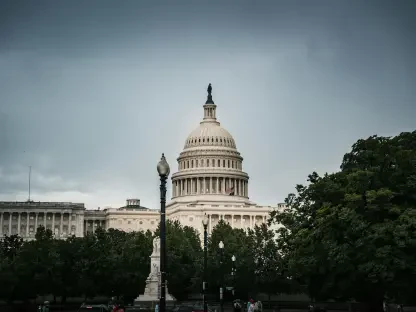As the US bond market experiences one of its most notable rallies in recent memory, with the Bloomberg Treasuries index posting gains in eight of the past ten months, a pressing question looms over investors and analysts alike. Despite this impressive performance, the market appears to be treading water, confined to a narrow trading range due to a glaring absence of fresh economic data. With US 10-year yields dipping toward 4% amid heightened demand driven by volatility in stocks and cryptocurrencies, the lack of clear catalysts has left Treasuries in a state of limbo. This uncertainty is further compounded by mixed signals from the Federal Reserve and external disruptions like a recent government shutdown, which have muddled economic indicators. The stage is set for a deeper exploration into whether this rally can hold its ground without the critical data needed to guide investor sentiment and policy decisions.
Market Dynamics and Current Trends
Rally Performance and Stagnation
The US bond market, valued at an astounding $30 trillion, has showcased a robust rally, positioning it for one of its strongest performances in years. However, despite the positive momentum, the market seems stuck in a holding pattern as of late November. Prices remain below the highs seen in October, and the narrow trading range reflects a distinct lack of conviction among investors. This stagnation, often described as the market being “stuck in the mud,” stems from a void of significant economic releases that could provide direction. Without major indicators expected until after the Federal Reserve’s December meeting, investors find themselves in a waiting game, unable to anticipate whether the current gains will persist or falter under mounting uncertainty. The dip in 10-year yields toward 4% signals demand, yet without a definitive trigger, the rally’s sustainability remains in question. This peculiar balance of optimism and indecision continues to define the landscape, leaving market participants searching for clarity.
Volatility and External Influences
Beyond the internal dynamics of the bond market, external factors are adding layers of complexity to the current scenario. Volatility in equity markets and cryptocurrencies has driven some investors toward the relative safety of Treasuries, bolstering demand and contributing to the yield decline. Yet, this flight to safety is not enough to break the market out of its current range-bound state. The recent government shutdown has further distorted economic signals, making it harder for analysts to gauge the true state of the economy. Such disruptions have also deepened divisions among Federal Reserve policymakers, with opinions split on the necessity of further rate adjustments. Market volatility, while near historical lows, underscores a broader lack of confidence, as participants hesitate to make bold moves without concrete data. These external pressures highlight the fragility of the rally, suggesting that any sustained momentum may hinge on unexpected risk-off events or a sudden shift in economic conditions.
Federal Reserve Policy and Economic Indicators
Uncertainty Surrounding Rate Decisions
The Federal Reserve’s next steps are a focal point of debate as the bond market navigates this data vacuum. Recent remarks from John Williams, president of the Federal Reserve Bank of New York, have reignited speculation about a potential interest rate cut in December, with market odds for such a move climbing to roughly 65%. Williams pointed to a softening labor market as a reason for possible rate reductions, yet mixed employment figures from September have failed to provide a clear path forward. This ambiguity has left investors and analysts divided on the likelihood of a third consecutive rate cut. While some see room for monetary easing, others caution that persistent above-target inflation could temper such expectations. The uncertainty surrounding Fed policy is a critical factor in the bond market’s current state, as any decision could either propel the rally further or stall it entirely. Until more definitive guidance emerges, the market remains in a state of cautious anticipation.
Need for Hard Data as a Catalyst
Analysts widely agree that the bond market’s ability to sustain its rally depends heavily on the arrival of hard economic data to break the current deadlock. Experts like Kathy Jones from a prominent financial institution have emphasized that without concrete indicators, a meaningful surge in bond prices is unlikely. Similarly, insights from Kevin Flanagan of a noted investment firm suggest that yields are unlikely to drop below the 4% threshold without a significant trigger. The complexity of the situation is further highlighted by Amar Reganti of a respected fund, who notes that while a December rate cut appears plausible, the combination of stubborn inflation and a lagging labor market creates room for debate on both sides. This lack of consensus among strategists underscores the critical role that upcoming data will play in shaping market direction. Until such information becomes available, the bond market is poised to remain range-bound, with investors unable to commit to a decisive stance on future movements.
Looking Ahead: Navigating the Data Void
Reflecting on Past Challenges
Looking back, the bond market’s journey through late November revealed a landscape marked by both promise and paralysis. The rally, while impressive with consistent gains over recent months, encountered significant hurdles due to the absence of fresh economic data. The mixed signals from employment figures and inflation metrics, coupled with the Federal Reserve’s ambiguous stance, created an environment of indecision that was palpable among investors. External disruptions, such as the government shutdown, only deepened the fog, distorting critical indicators and leaving policymakers divided. The market’s inability to break free from its narrow trading range was a testament to the challenges posed by this data vacuum, as even the allure of lower yields failed to ignite sustained momentum. This period served as a stark reminder of how reliant financial markets are on timely and reliable information to fuel confidence and direction.
Strategies for Future Stability
Moving forward, the bond market’s path hinges on actionable steps to navigate the current uncertainty. Investors and analysts must prioritize monitoring any forthcoming economic releases that could serve as catalysts for change, particularly after the Federal Reserve’s December meeting. Keeping a close eye on labor market trends and inflation data will be essential in gauging the likelihood of policy shifts. Additionally, market participants should prepare for potential risk-off events that could drive further demand for Treasuries, offering a buffer against volatility in other asset classes. Policymakers, on the other hand, face the task of providing clearer communication to reduce ambiguity and guide expectations. As the market awaits these developments, a strategic focus on adaptability and vigilance will be key to sustaining the rally’s gains. Exploring diversified approaches to risk management could also help mitigate the impact of unexpected disruptions, ensuring that the bond market remains resilient in the face of ongoing challenges.









